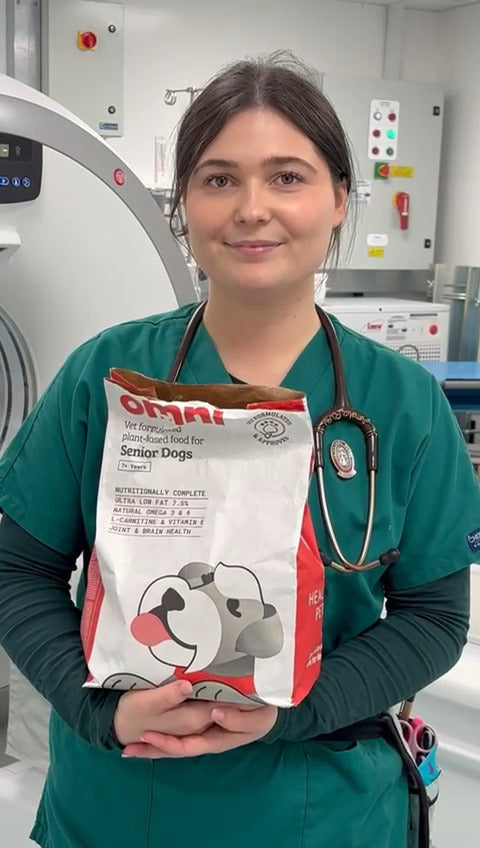Why Does My Dog Smell Like Fish?

Jenny from London asks: “Why does Ron smell like fish?”
Ron, in case you were wondering, is her 6-year-old Doberman.
Fishy dogs are a fairly common occurrence, even if unpleasant, so we thought it was about time that somebody tackled the issue head-on and gave you the answers you need.
So, without further ado, here’s what our Chief Vet Dr Guy Sandelowsky recommends:
Reasons Why Your Dog Smells Like Fish
1. Your Dog May Have Dental Disease
A fishy smell from the front of your dog (i.e., around their mouth) implies that they may have dental disease - although this can also be due to licking their anal glands (see below).
Dental disease is, unfortunately, very common in dogs. Around 80-90% of dogs over the age of 3 have some component of periodontal (dental) disease, according to Cornell University.
Dental disease can come as a result of poor quality food or improper oral hygiene, such as not having your dog’s teeth brushed regularly, or not using plaque-removing Fresh Breath chews.
How to Spot if Your Dog Has Dental Disease
- Sore mouth. If your dog’s mouth seems sore (either red and inflamed or they are hesitant to let you touch it), there is a good chance they have some component of dental disease.
- Blood from the mouth. If portions of your dog’s mouth are bleeding, such as around teeth or gums, it is a good sign that they have dental disease.
- Dirty teeth. Having dirt in their teeth is a likely source of bacteria and other nasty pathogens that play a part in inflamed, sore, diseased gums. This could be where the fishy smell comes from!
How to Help Your Dog with Periodontal Disease
- Seek veterinary advice for proper oral hygiene, and consider a veterinary dental procedure. It can be costly, but it is worth it to keep your dog happy and fit!
- Brush your dog’s teeth with doggy toothpaste. Don’t use human toothpaste for this! And remember that dogs may not enjoy having their teeth cleaned, so it might be something you have to train them into by doing it little and often.
2. Your Dog May Have Anal Glands Problems
Anal glands are two small glands either side of your dog’s anus that normally should express themselves whenever your dog goes to the toilet.
However, a diet that is too low in fibre can mean that the stools aren’t bulky enough to naturally express your dog’s anal glands. There are other causes of anal gland problems, too, including the breed of your dog.
Key Signs of Anal Gland Problems in Dogs:
- Scooting: Dogs can often drag their rear ends around on the floor to try and release the glands as they can feel itchy to your dog. Scooting is a prime sign of anal gland impaction.
- Nibbling around or under their tail: Like scooting, this is a form of your dog trying to itch their rear end to relieve the pressure of overly full anal glands.
What You Should Do:
- Seek veterinary advice: If your dog is showing the symptoms of blocked anal glands, you should seek veterinary advice if they have not been expressed before. However, some people can express the glands themselves, but it is not advised if you have not done it before without support from your vet..
- Consider adding anal gland supplements or other sources of fibre to their diet. Omni’s own Anal Gland Supplement has seen huge success for hundreds of dogs in situations like yours and is an easy way to help your dog’s anal gland problems go away.
Summary of Common Reasons for Dogs Smelling Like Fish:
- Dental disease: If the smell is coming from the front end, it’s probably dental disease! Start brushing their teeth more regularly and seek veterinary advice.
- Anal gland problems: If the smell is coming from their rear, there’s a good chance your dog is having issues with their anal glands. Take them to your local vets and start them on a higher-fibre diet or an anal gland-specific supplementation programme.
When to Contact a Vet
You should contact a vet if:
- Your dog is showing the signs of blocked anal glands
- Your dog seems to have dental disease
- Your dog has other symptoms that are not covered by this article
If you’re worried about your dog’s health, it’s always best to get professional advice. Book a free consultation with our vet team at Omni for expert guidance on what could be causing your dog’s excessive panting and how to manage it.
Thoughts from Dr Guy MRCVS
As dog lovers and guardians, it’s natural to worry about our furry friends, especially when they display abnormal symptoms that can’t be easily explained. That’s why, when I founded Omni, I knew that I wanted to keep vet consultation free and accessible at the heart of the business.
If you’re understandably worried about your dog, but you don’t think you need to take them to the vets urgently, I highly recommend getting some friendly, professional advice from one of our team.
Explore some of the frequently asked questions in our Ask a Vet series
Got a question for the Ask a Vet team?
Submit your question via email to woof@omni.pet. We’ll get back to you as soon as we can, and, if suitable, post the response here to help others, too!
Disclaimer: Our Video Vet Consultation service is limited because we are unable to perform a full physical examination of your pet. Our vets have no responsibility for the examination or other medical services provided during the Consultation.
Please note that our Video Vet Consultations do not replace traditional veterinary care, but can provide additional support. Based on the information you have provided and the symptoms you have described, the Vet will give you advice and an ongoing plan. Without a physical examination, we cannot provide a definitive diagnosis. If you are worried that your dog's condition is worsening, or you need additional support, please schedule another consultation, or see your registered vet.







 85 Great Portland Street, 1st Floor, London, W1W 7LT United Kingdom
85 Great Portland Street, 1st Floor, London, W1W 7LT United Kingdom





